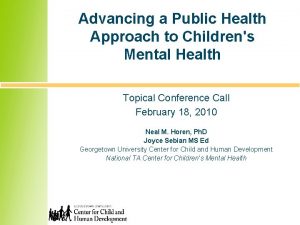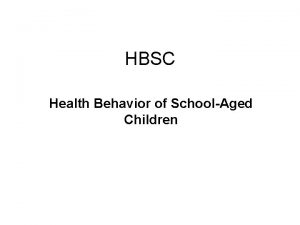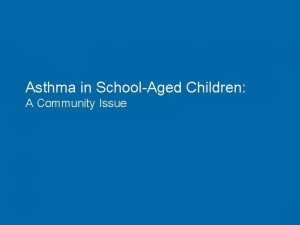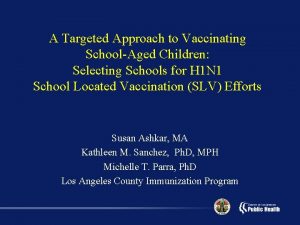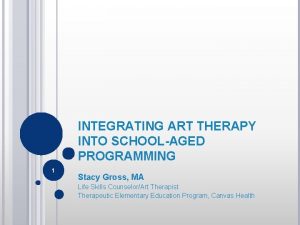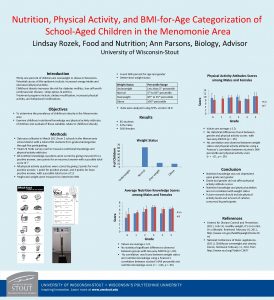Improving the Health of Elementary SchoolAged Children Whats




















- Slides: 20

Improving the Health of Elementary School-Aged Children What’s Happening at School? Annual Conference of the Association of Maternal and Child Health Programs, Washington DC. March 10, 2003. Julia Graham Lear, Ph. D, Director, Center for Health and Health Care in Schools, School of Public Health and Health Services, The George Washington University. The Center for Health and Health Care in Schools 1

The Health of Elementary School. Aged Children & Schools: Overview • Introduction: why schools; what challenges? • Promising interventions to improve access and promote healthy behaviors • Partnering with parents to optimize benefits from school-based programs • Securing MCH goals through school-based initiatives 2

Why Schools? A school “base” enables providers to overcome access barriers for most children. 50 million American children and youth between ages 5 and 17 attend school; 90% attend public schools. Perversely, economic and racial segregation in schools enables targeting services and programs on those populations with greatest unmet need. 3

On-going Questions for School. Based Health Programs • Population-targeted practice v. individualtargeted practice? • Which services or programs to offer? Prevention? Screening? Diagnosis? Shortterm interventions? Long-term services? • Whose goals? Are health programs in schools supporting an education agenda or a health agenda? 4

Promising Health Programs in School • Programs that increase access to care – School-based health or wellness centers – Mental health services in school – Dental health programs in school • Programs that promote healthy behaviors – Physical exercise – nutrition programs 5

Programs that Increase Access to Care: School-Based Health Centers • Sponsored by mainstream health care organizations • Offer comprehensive range of services • Generally require parental consent • Work with school health personnel, and • Supported by community advisory committees 6

National Survey of State SBHC Initiatives School Year 20012002 12 0 44 27 0 4 5 19 0 0 1 0 35 2 135 97 41 45 30 33 14 21 37 18 0 7 68 27 16 57 23 33 63 26 10 31 9 6 49 53 6 1 67 170 5 3 53 0 1 89 Map reports number of centers by state for school year 2001 -2002. Data from the 2002 State Survey of SBHCs sponsored by the Center for Health and Health Care in Schools 7

2002 State Survey: Location of School-Based Health Centers 8

2002 State Survey: Types of Schools Housing School-Based Health Centers 9

2002 State Survey: State Policies and Programs to Support SBHCs (N=51) # of states State office provides technical assistance regarding SBHCs 26 State grant programs support SBHCs 19 SBHCs eligible for Medicaid fee-for-service reimbursement 44 State laws permit nurse practitioners to primary care providers under care 31 participate a Medicaid managed 10

Programs that Increase Access to Care: School-Based Mental Health Services • Schools may function as de facto mental health system for children & adolescents: 80% provide crisis intervention services; 60% plus have mental health professionals on staff • Of children receiving mental health services, 7080% receive that care in a school setting. • Model programs: Dallas ISD, SBHCs, • Challenge for MCH: most school-based mental health organized by school system or mental heath agencies 11

Mental Health Service Providers in Schools Service Provider Arrangement School Relationship Provider Type Services Barriers Hired by school or school district School Psychologists Special Education Testing, IDEA implementation Time spent on testing, not accessible to all students Stand Alone Sch Program School or school district hires providers or program Social Workers, child psychologists, teachers Counseling, Interventions for specific mental health issues Stigma, Time, Program cost Community Linked School or school district contracts with organization for the provision of services Social Workers, child psychologists, psychiatrist, crisis counselors Varied – crisis/ as needed to comprehensive mental health services Not linked to other school services, providing as needed does not address issue of lack of services Other Service Provider Options May occur on school premises but not during school hours Varied Not always linked to school services, may not reach all needy children School Based Health Centers Located at or near schools Varied Funding and space Special Education The Center for Health and Health Care in Schools 12

Programs that Increase Access to Care: School-Based Dental Health Programs Children’s dental needs • Tooth decay: one of most common chronic childhood diseases; 5 times more common than asthma. • Tooth decay afflicts children in poverty twice as much as their affluent peers; racial disparities are significant. • According to the CDC: school-based dental programs could reduce or eliminate racial and income disparities among children with sealants. 13

School-Based Dental Health Programs continued Types of programs • Screen and refer • Sealants • Comprehensive assessment, preventive services and restorations Model programs: Dent. Care (NY), Hartford Public Schools (CT) 14

School-Based Dental Health Programs continued Key factors in program development – Public & private insurance payments – Scope of practice for dental hygienists – Political dynamics in state dentistry profession 15

PARENTS: A New Focus for Building Stronger School Health Programs • At school: Parents historically uninformed about school’s health & safety arrangements and programs • In community at large: Increased support for consumer participation in organization of health services • Two CHHCS parent initiatives – CHHCS Parent Poll, Spring 2003 – Parents’ Resource Center 16

CHHCS Poll: Parents Speak Out on Health and Health Care in Schools • • In the field, end of February through early March Responders: parents, with oversampling by income Initial results -- late March; final report late April Sample questions (not exact wording): – In general do you support or oppose providing health care in schools? (Strongly support to strongly oppose) – What services to you think it is important to be provided to kids in school? – Do you think it is important to educate kids about health? Eg. issues like eating right and exercising? 17

Emotions & Behaviors Health, General Nutrition & Fitness Safety Getting Things Done At School Keeping Children Safe Helping Children Stay Healthy The Center for Health and Health Care in Schools Asthma is the most common chronic disorder in children and is a leading cause of disability. Click here to learn more 18

MCH Opportunities to Strengthen Children’s Health through In-School Programs • Challenges: State budgets, uncertain politics, unsteady partnerships between health & education • Opportunities: – Web initiatives • Build an information base for parents and school staff • Create and/or support state standards for effective programs – Fund outcomes-focused projects – Don’t ignore politics 19

Contact Information The Center for Health and Health Care in Schools 1350 Connecticut Avenue, NW Suite 505 Washington, DC 20036 202 -466 -3396 202 -466 -3467 fax www. healthinschools. org The Center for Health and Health Care in Schools 20
 Existanxe
Existanxe National programs
National programs Children's mental health
Children's mental health National children's digital health collaborative
National children's digital health collaborative Green paper children's mental health
Green paper children's mental health Hình ảnh bộ gõ cơ thể búng tay
Hình ảnh bộ gõ cơ thể búng tay Ng-html
Ng-html Bổ thể
Bổ thể Tỉ lệ cơ thể trẻ em
Tỉ lệ cơ thể trẻ em Voi kéo gỗ như thế nào
Voi kéo gỗ như thế nào Tư thế worm breton là gì
Tư thế worm breton là gì Alleluia hat len nguoi oi
Alleluia hat len nguoi oi Môn thể thao bắt đầu bằng chữ f
Môn thể thao bắt đầu bằng chữ f Thế nào là hệ số cao nhất
Thế nào là hệ số cao nhất Các châu lục và đại dương trên thế giới
Các châu lục và đại dương trên thế giới Cong thức tính động năng
Cong thức tính động năng Trời xanh đây là của chúng ta thể thơ
Trời xanh đây là của chúng ta thể thơ Cách giải mật thư tọa độ
Cách giải mật thư tọa độ Phép trừ bù
Phép trừ bù Phản ứng thế ankan
Phản ứng thế ankan Các châu lục và đại dương trên thế giới
Các châu lục và đại dương trên thế giới


